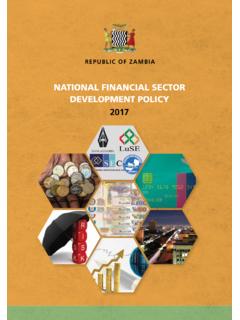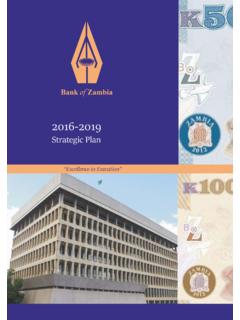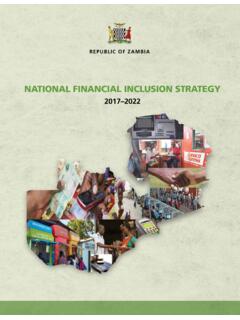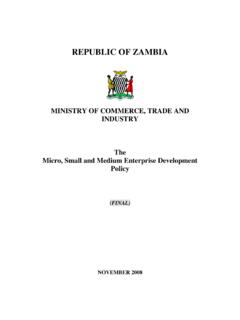Transcription of Republic of Zambia National Financial Inclusion Strategy ...
1 Republic of Zambia National Financial Inclusion Strategy 2017 -2022 DRAFT February 18, 2017 1 Table of Contents Abbreviations and Acronyms .. 2 Executive Summary .. 3 1. Introduction .. 5 Rationale for a National Financial Inclusion Strategy .. 6 Financial Sector Context .. 8 Defining Financial Inclusion .. 9 The Vision .. 9 2. The Current State of Financial Inclusion .. 11 3. NFIS Framework .. 30 Key Enablers .. 31 Public and Private Sector Commitment / Coordination .. 31 Policy / Legal / Regulatory Environment and Supervisory Capacity.
2 32 Financial Infrastructure .. 32 Key Drivers .. 32 Widespread and Accessible Delivery Channels .. 33 Diverse, Innovative, and Customer-Centric Products .. 33 Finance for SME and Agricultural Sector Growth .. 34 Financial Consumer Protection and Capability .. 34 4. Coordination Structure .. 35 NFIS Steering Committee .. 36 NFIS Implementation Committee .. 36 NFIS Secretariat .. 38 Working Groups .. 39 5. Monitoring & Evaluation System .. 40 Tracking Implementation of the NFIS .. 40 National Results Framework.
3 41 Financial Inclusion Data Infrastructure .. 45 Evaluation of Key Actions .. 45 6. Action 46 Annex 1: Working Groups .. 52 Annex 2: Financial Inclusion Data Sources .. 54 2 Abbreviations and Acronyms AFI Alliance for Financial Inclusion AML Anti-Money Laundering BOZ Bank of Zambia CCPC Competition and Consumer Protection Commission CFT Combating the Financing of Terrorism CSO Central Statistics Office EDR External Dispute Resolution FISF Financial Inclusion Support Framework (World Bank) FSDP Financial Sector Development Plan FSDZ Financial Sector Deepening Zambia FSP Financial Service Provider G2P Government-to-Person GRZ Government of the Republic of Zambia KYC Know Your Customer KPI Key Performance Indicator NFIS National Financial Inclusion Strategy NSFE National Strategy on Financial Education MFI Microfinance Institution MNO Mobile Network Operator MOF Ministry of Finance PIA Pensions and Insurance Authority POS Point of Sale RUFEP Rural Finance Expansion Program SACCO
4 Savings and Credit Cooperatives SEC Securities and Exchange Commission SME Small and Medium-sized Enterprise ZEHCL Zambia Electronic Clearing House Limited 3 Executive Summary In support of Vision 2030, this National Financial Inclusion Strategy (NFIS) is being adopted by the Government of the Republic of Zambia (GRZ) in [June] 2017 . The vision of this NFIS is to have universal access and usage of a broad range of quality and affordable Financial products and services.
5 In achieving this vision, it is expected that all Zambians will reap the full benefits of Financial Inclusion : that is, individuals will be able to use appropriate savings, credit, payment, insurance, and investment services to manage risks, plan for the future, and achieve their goals; and firms will be able to access affordable financing to innovate, grow, and create employment. Despite recent progress on Financial Inclusion , much remains to be done to achieve this vision.
6 Over 40 percent of Zambian adults are excluded from the Financial sector; and nearly 80 percent do not use Financial products and services from regulated providers. Significant discrepancies also remain between rural and urban areas, men and women, youth and adults, and SMEs and large firms. The potential to leverage digital technologies, to reduce costs and expand the reach of the formal Financial sector has not yet been fully realized. Nonbank Financial institutions like microfinance institutions, insurance companies, and pension providers have limited reach.
7 Low levels of Financial capabilities among some consumers and limited consumer protection mechanisms also constrain the ability and willingness of consumers to use formal Financial products and services to meet their goals. To address these gaps, this NFIS sets forth a coordinated and sequenced set of actions to be executed by the public and private sectors. The successful implementation of these actions will achieve the following: An increase in Financial Inclusion from 59% to 80% by 2022. Improved physical access to high-quality Financial delivery channels, including branches, agents, ATMs, and mobile phones as the percentage adults using an electronic payment instrument will grow from 37% to 55% by 2022.
8 Innovative and diverse Financial products and services that meet customers needs as the percentage of adults with a store-of-value transaction account will grow from 36% to 70% by 2022. Greater availability of affordable financing for SMEs, small holder farmers and agricultural firms as the percent of SMEs indicating access to credit as a major constraint will decrease from 27% to 20% by 2022. 4 Enhanced consumer protections and increased Financial capabilities of consumers as the percentage of adults with adults with low Financial knowledge levels will decrease from 17% to 10% by 2022.
9 The NFIS framework (below) represents these four areas as Drivers , which are in turn supported by three key Enablers : (i) Public and Private Sector Commitment and Coordination; (ii) Policy, Legal, and Regulatory Environment and Supervisory Capacity; and (iii) Financial Infrastructure. Figure ES. 1: NFIS Framework The implementation of this NFIS will be guided by a Coordination Structure that leverages expertise and resources from both the public and private sectors. Measurement of progress towards the NFIS vision and objectives will be supported by a robust Monitoring & Evaluation System, which includes a range of National -level and action-level key performance indicators and targets.
10 Chief among these targets is the achievement of 80 percent Financial Inclusion by 2022 (at least 50 per cent of which should be formal). Zambia joins more than 30 countries that have or are developing National Financial Inclusion Strategies. This NFIS represents a renewed commitment to Financial Inclusion in 5 Zambia , and builds on previous, relevant efforts ( , FSDP, FSDP II) as well as existing, ongoing commitments by Government. Implementation of this NFIS will be pursued in parallel to complementary Financial sector objectives, including Financial stability and Financial integrity.
![CAP. 387] REPUBLIC OF ZAMBIA THE BANKING AND …](/cache/preview/a/c/f/7/7/6/9/9/thumb-acf776999ed995e5170a1eeb0ace514f.jpg)














